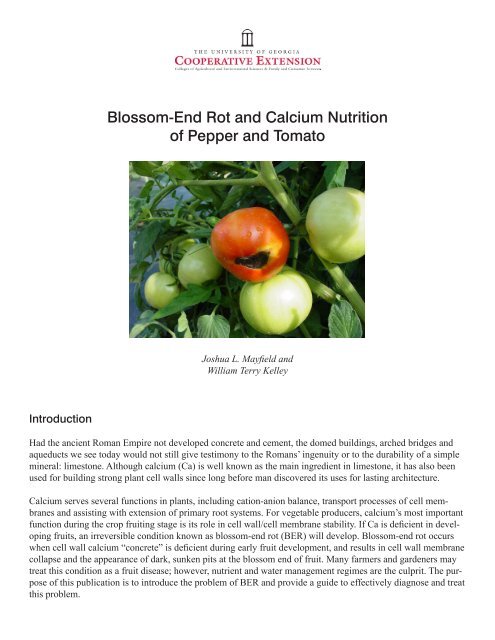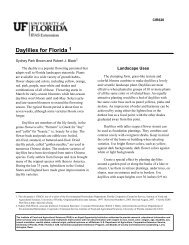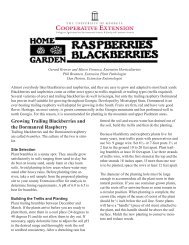Blossom-End Rot and Calcium Nutrition of Pepper and Tomato
Blossom-End Rot and Calcium Nutrition of Pepper and Tomato
Blossom-End Rot and Calcium Nutrition of Pepper and Tomato
Create successful ePaper yourself
Turn your PDF publications into a flip-book with our unique Google optimized e-Paper software.
<strong>Blossom</strong>-<strong>End</strong> <strong>Rot</strong> <strong>and</strong> <strong>Calcium</strong> <strong>Nutrition</strong><br />
<strong>of</strong> <strong>Pepper</strong> <strong>and</strong> <strong>Tomato</strong><br />
Joshua L. Mayfield <strong>and</strong><br />
William Terry Kelley<br />
Introduction<br />
Had the ancient Roman Empire not developed concrete <strong>and</strong> cement, the domed buildings, arched bridges <strong>and</strong><br />
aqueducts we see today would not still give testimony to the Romans’ ingenuity or to the durability <strong>of</strong> a simple<br />
mineral: limestone. Although calcium (Ca) is well known as the main ingredient in limestone, it has also been<br />
used for building strong plant cell walls since long before man discovered its uses for lasting architecture.<br />
<strong>Calcium</strong> serves several functions in plants, including cation-anion balance, transport processes <strong>of</strong> cell membranes<br />
<strong>and</strong> assisting with extension <strong>of</strong> primary root systems. For vegetable producers, calcium’s most important<br />
function during the crop fruiting stage is its role in cell wall/cell membrane stability. If Ca is deficient in developing<br />
fruits, an irreversible condition known as blossom-end rot (BER) will develop. <strong>Blossom</strong>-end rot occurs<br />
when cell wall calcium “concrete” is deficient during early fruit development, <strong>and</strong> results in cell wall membrane<br />
collapse <strong>and</strong> the appearance <strong>of</strong> dark, sunken pits at the blossom end <strong>of</strong> fruit. Many farmers <strong>and</strong> gardeners may<br />
treat this condition as a fruit disease; however, nutrient <strong>and</strong> water management regimes are the culprit. The purpose<br />
<strong>of</strong> this publication is to introduce the problem <strong>of</strong> BER <strong>and</strong> provide a guide to effectively diagnose <strong>and</strong> treat<br />
this problem.
D. Langston, UGA<br />
Diagnosis Guide<br />
Although no data exists to quantify how much annual economic impact blossom-end rot has on Georgia’s bell<br />
pepper <strong>and</strong> tomato industries, it is safe to say that significant loss <strong>of</strong> fruit occurs during the spring crop season,<br />
especially during hot, dry years. What is also unknown in the vegetable research realm is if a single cause leads<br />
to BER, or if (as past research indicates) multiple factors contribute to its occurrence. One fact that everyone<br />
can agree on is that when BER is first noticed in the field, prompt action is essential to halt further incidence.<br />
Four simple questions in the field will lead to a timely diagnosis <strong>and</strong> treatment <strong>of</strong> the problem:<br />
1. Is the problem disease- or nutrient-related? There are only a few common fruit disorders resembling BER<br />
that can lead to an incorrect diagnosis <strong>of</strong> the problem. Fruit anthracnose may occur on pepper <strong>and</strong> tomato fruit,<br />
but only on the side walls. The same is true for sunscald, which<br />
appears on pepper fruit sidewalls <strong>and</strong> is pale in color. Buckeye<br />
rot, caused by Phytophthora, <strong>and</strong> cucumber mosaic virus (CMV)<br />
also resemble BER, but these disorders occur more infrequently<br />
Figure 1. Buckeye rot <strong>of</strong> tomato caused by<br />
Phytophthora.<br />
Recommendation: If these conditions all hold true, proceed to Question #2.<br />
than anthracnose. <strong>Blossom</strong>-end rot is uniformly dark brown <strong>and</strong><br />
black in color, <strong>and</strong> appears ONLY on either the lower fruit sidewall<br />
or the blossom end <strong>of</strong> smaller <strong>and</strong> developing fruit. Often,<br />
symptoms will occur as far as 1/3 to halfway up the fruit, but will<br />
NEVER start at the stem (calyx) end. Also, BER symptoms will<br />
tend to appear during the first fruit set as, early on, growers are<br />
unaware <strong>of</strong> the problem until it’s too late. If these symptoms all<br />
correspond, the fruit has BER.<br />
2. Is calcium fertilization adequate? Examine liming <strong>and</strong> gypsum<br />
application records, along with the current season’s pre-plant soil test reports.<br />
If pre-plant soil test Ca levels are in the medium (801 to 1,200 lbs.<br />
Ca/acre) or high range (>1,200 lbs. Ca/acre), it is assumed that soil Ca<br />
levels are sufficient for crop growth. This is even more true for soil pH ≥<br />
6.0, with supplemental gypsum or lime being applied pre-plant at levels<br />
<strong>of</strong> 500 to 1,000 lbs./acre or higher. If these conditions exist, proceed to<br />
Question #3.<br />
Equally important to soil test results is plant tissue analysis. For bell<br />
pepper, sufficient leaf tissue percent Ca content just prior to (or at) early<br />
bloom stage should be within the range <strong>of</strong> 1.0 to 2.5 percent. For tomatoes,<br />
percent Ca content prior to (or at) early bloom should be within the<br />
range <strong>of</strong> 1.25 to 3.20 percent. Tissue levels below these would point to a<br />
possible emerging Ca deficiency.<br />
Recommendation: No specific recommendations exist for alleviating<br />
a low soil Ca level after planting. However, calcium nitrate (CaNO 3<br />
) is<br />
a water soluble source <strong>of</strong> Ca <strong>and</strong> nitrogen (N) <strong>and</strong> is routinely injected<br />
in drip irrigation systems. Some research has begun on a relatively new<br />
material, calcium thiosulfate (CaS 2<br />
O 3<br />
), which also is available for drip<br />
injection systems. Injections <strong>of</strong> soluble Ca sources should begin at<br />
bloom <strong>and</strong> proceed until fruit is approximately golf ball-sized. This<br />
is believed to be the critical time when calcium must move into developing<br />
fruit to avoid onset <strong>of</strong> BER.<br />
Figure 2. <strong>Blossom</strong>-end rod <strong>of</strong> tomato.<br />
Figure 3. Severe BER symptoms<br />
progress from the blossom to the stem<br />
(calyx) end <strong>of</strong> the fruit.<br />
Joshua Mayfield<br />
Joshua Mayfield
Joshua Mayfield<br />
D. Langston, UGA<br />
Figure 4. Sunscald (or sunburn) on pepper<br />
with BER-like symptoms.<br />
Figure 5. <strong>Pepper</strong> Anthracnose with BER-like<br />
symptoms.<br />
E. Maynard, Purdue Univ.<br />
Although some people believe foliar sprays can correct Ca deficiency in developing fruits, research is very<br />
inconclusive on this issue. What is well known is that Ca only moves in the plant via the xylem <strong>and</strong> moves with<br />
the transpirational water flow from the roots, up the plant <strong>and</strong> into developing leaves. <strong>Calcium</strong> has no ability to<br />
flow from the leaves via the phloem to the developing fruit. In addition, once fruit has grown to golf ball size,<br />
the waxy outer layer has developed <strong>and</strong> is believed to be quite impermeable to water. Therefore, it is recommended<br />
that all Ca supplied to fruiting vegetables be applied via the irrigation water so as to maximize uptake<br />
by roots. If liquid fertilizers are already being used, proceed to Question #3.<br />
3. Is nitrogen <strong>and</strong> potassium fertilization excessive? Research has shown that Ca in soil solution competes<br />
with potassium (K), magnesium (Mg) <strong>and</strong> ammonium-nitrogen (NH 4<br />
-N) for uptake in the plant. Although no<br />
established guidelines exist to determine what proportions <strong>of</strong> these nutrients in soil or plant tissue are appropriate,<br />
it is known that excessive shoot growth resulting from overfertilization <strong>of</strong> N <strong>and</strong> K during early bloom <strong>and</strong><br />
fruiting stages is a major contributor to BER in developing fruit. Since Ca moves with the transpirational water<br />
flow, water is going to go to areas <strong>of</strong> new shoot growth that have the greatest transpirational dem<strong>and</strong>. <strong>Calcium</strong><br />
will therefore be deposited in the new shoot <strong>and</strong> leaf tissues that result from excess fertilization, <strong>and</strong> little will<br />
end up in developing fruit where it is needed most. At early bloom stage for bell pepper <strong>and</strong> tomato, leaf N <strong>and</strong><br />
K analysis should both be within 4.0 to 6.0 percent. Levels higher than these may indicate excess fertilizer.<br />
Recommendation: Cut rates <strong>of</strong> N <strong>and</strong> K if excessive top growth is occurring. Switch N source to CaNO 3<br />
or begin<br />
injections <strong>of</strong> CaS 2<br />
O 3<br />
at bloom stage. If these steps are already being implemented, proceed to Question #4.<br />
Figure 6. <strong>Blossom</strong>-end rot <strong>of</strong><br />
bell pepper.<br />
4. Is irrigation adequate? Some people believe the relative humidity <strong>and</strong><br />
transpirational rates <strong>of</strong> tomato <strong>and</strong> pepper during the spring season are the real<br />
keys to underst<strong>and</strong>ing what factors trigger BER in fruiting vegetables. Fluctuations<br />
<strong>of</strong> soil moisture, as happens during a week <strong>of</strong> <strong>of</strong>f-<strong>and</strong>-on rain, may trigger<br />
BER due to irregular transpiration rates, affecting the quantities <strong>and</strong> timing <strong>of</strong><br />
water <strong>and</strong> Ca moving up the xylem. Conversely, during hot, dry weather when<br />
transpiration is occurring at a much faster rate, developing vegetative parts such<br />
as growing leaves <strong>and</strong> stems become greater sinks for Ca than developing fruits.<br />
Lastly, as the waxy outer layer <strong>of</strong> a tomato or pepper fruit develops, the fruit’s<br />
transpiration rate decreases because water movement through the epidermal<br />
cells <strong>and</strong> evaporation into the outside air become difficult. The resulting decrease <strong>of</strong> Ca that flows into those<br />
young fruit tissues via xylem transport is believed to contribute to the onset <strong>of</strong> BER.<br />
Recommendation: Some research findings have quantified a decrease <strong>of</strong> BER incidence with increased irrigation<br />
rates. However, no recommendations exist for determining the critical moisture levels required in soils to<br />
minimize this disorder, nor is information available regarding the severity <strong>of</strong> moisture deficits triggering BER.
For now, the “feel” method is still the most tried <strong>and</strong> true method <strong>of</strong> assessing soil moisture in the field. Along<br />
the row <strong>and</strong> out to the shoulders <strong>of</strong> the bed, the soil should be moist enough to form a ball in your h<strong>and</strong> <strong>and</strong> not<br />
break apart. The optimal time to increase irrigation <strong>and</strong> ensure that adequate moisture is being supplied is from<br />
first bloom set through fruit development. If BER initiates in fruit, it is believed to be during this early stage <strong>of</strong><br />
development.<br />
Certain occasions exist where farmers run irrigation pumps “round<br />
the clock” <strong>and</strong> soil still will not form <strong>and</strong> hold a good ball shape.<br />
This may indicate that irrigation dem<strong>and</strong> during the fruiting period is<br />
greater than that for which the pumping system was designed.<br />
Summary<br />
It is believed that both nutritional <strong>and</strong> environmental factors need to<br />
be considered when diagnosing BER <strong>and</strong> recommending treatments.<br />
First, a correct diagnosis must be made to avoid recommending<br />
costly fungicide sprays when none are needed. Next, a careful examination<br />
<strong>of</strong> a grower’s soil test <strong>and</strong> leaf analysis records, in addition to their irrigation management practices,<br />
will help determine if additional Ca alone or in combination with increased irrigation scheduling will solve the<br />
problem. Equipped with a basic knowledge <strong>of</strong> plant growth, fruit development <strong>and</strong> Ca movement in soils <strong>and</strong><br />
plant xylem tissue, growers will have the tools necessary for diagnosing <strong>and</strong> correcting the adverse effects <strong>of</strong><br />
blossom-end rot.<br />
Further Reading<br />
Figure 7. <strong>Blossom</strong>-end rot <strong>of</strong> jalapeno<br />
pepper.<br />
Adams, P. <strong>and</strong> L.C. Ho. 1993. Effects <strong>of</strong> environment on the uptake <strong>and</strong> distribution <strong>of</strong> calcium in tomato <strong>and</strong> on the incidence <strong>of</strong><br />
blossom-end rot, pp. 583-588. IN: M.A.C. Fragoso <strong>and</strong> M.L. van Beusichem (eds.) Optimization <strong>of</strong> plant nutrition. Kluwer Academic<br />
Publishers, Netherl<strong>and</strong>s.<br />
Bar-tal, A., B., Aloni, L., Karni, J., Oserovitz, A., Hazan, M., Itach, S., Gantz, A., Avidan, I., Posalski, N., Tratkovski, <strong>and</strong> R. Rosenberg.<br />
2001. Nitrogen nutrition <strong>of</strong> greenhouse pepper. I. Effects <strong>of</strong> nitrogen concentration <strong>and</strong> NO 3<br />
:NH 4<br />
ratio on yield, fruit shape, <strong>and</strong><br />
the incidence <strong>of</strong> blossom-end rot in relation to plant mineral composition. Hortscience 36(7):1244-1251.<br />
Hansen, M.A. 2000. <strong>Blossom</strong> end rot <strong>of</strong> tomato. Publication 450-703W. Virginia Cooperative Extension Plant Disease Factsheets,<br />
Virginia Polytechnic Institute <strong>and</strong> State University, Blacksburg, VA.<br />
Moustafa, S.A., Ibrahim, S.A., <strong>and</strong> M.A. El-shal. 1979. The effect <strong>of</strong> spraying boron, calcium <strong>and</strong> magnesium on the occurrence <strong>of</strong><br />
blossom-end rot <strong>of</strong> tomatoes. Alex<strong>and</strong>ria Jour. Agric. Res. 27(4):223-230.<br />
Sperry, W.J., Davis, J.M., <strong>and</strong> D.C. S<strong>and</strong>ers. 1996. Soil moisture <strong>and</strong> cultivar influence cracking, blossom-end rot, zippers, <strong>and</strong> yield<br />
<strong>of</strong> staked fresh-market tomatoes. HortTechnology 6(1):21-24.<br />
Taylor, M.D., Locascio, S.J., <strong>and</strong> M.R. Alligood. 2004. <strong>Blossom</strong>-end rot incidence <strong>of</strong> tomato as affected by irrigation quantity, calcium<br />
source, <strong>and</strong> reduced potassium. Hortscience 39(5):1110-1115.<br />
Taylor, M.D. <strong>and</strong> S.J. Locascio. 2004. <strong>Blossom</strong>-end rot: A calcium deficiency. J. Plant Nutr. 27(1):123-139.<br />
Wui, M. <strong>and</strong> T. Takano. 1995. Effect <strong>of</strong> calyx removal <strong>and</strong> air flow or bagging <strong>of</strong> the fruits during the fruiting stage on the incidence <strong>of</strong><br />
blossom-end rot in tomatoes, Lycopersicon esculentum L. Env. Control in Biology 33(1):15-21.<br />
Circular 938 March 2009<br />
The University <strong>of</strong> Georgia <strong>and</strong> Ft. Valley State University, the U.S. Department <strong>of</strong> Agriculture <strong>and</strong> counties <strong>of</strong> the state cooperating. Cooperative Extension, the University<br />
<strong>of</strong> Georgia College <strong>of</strong> Agricultural <strong>and</strong> Environmental Sciences, <strong>of</strong>fers educational programs, assistance <strong>and</strong> materials to all people without regard to race, color,<br />
national origin, age, gender or disability.<br />
An Equal Opportunity Employer/Affirmative Action Organization Committed to a Diverse Work Force<br />
E. Maynard, Purdue Univ.






